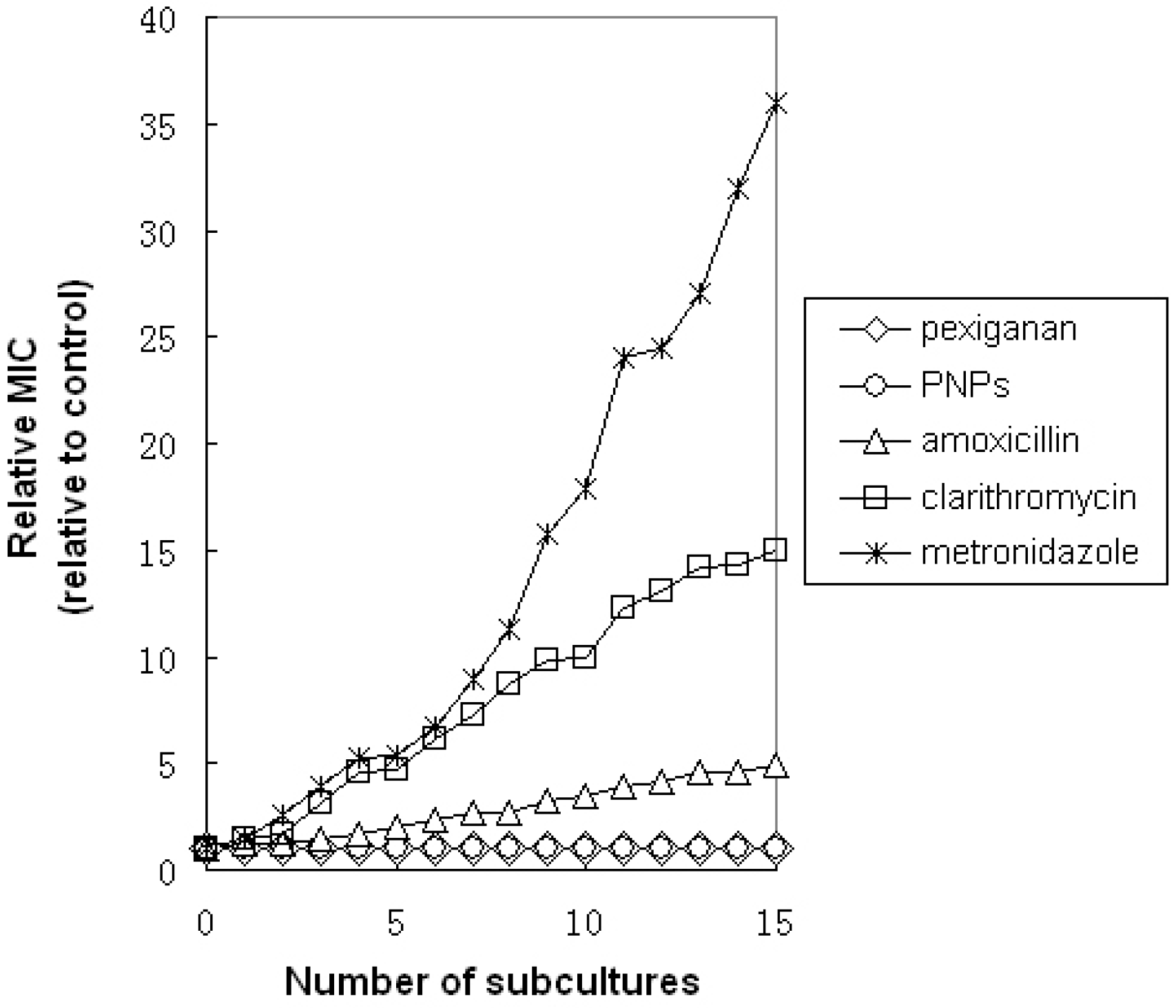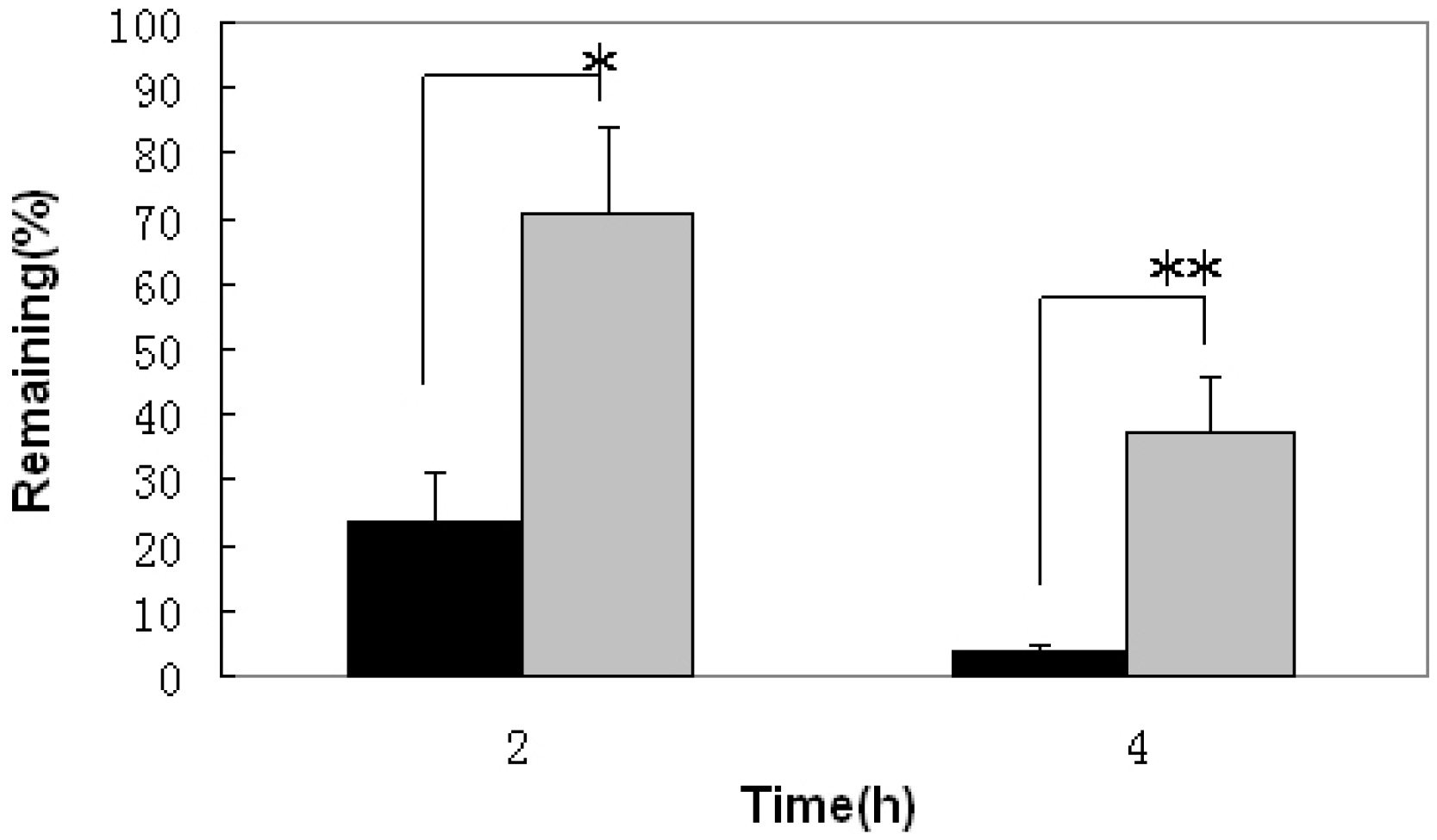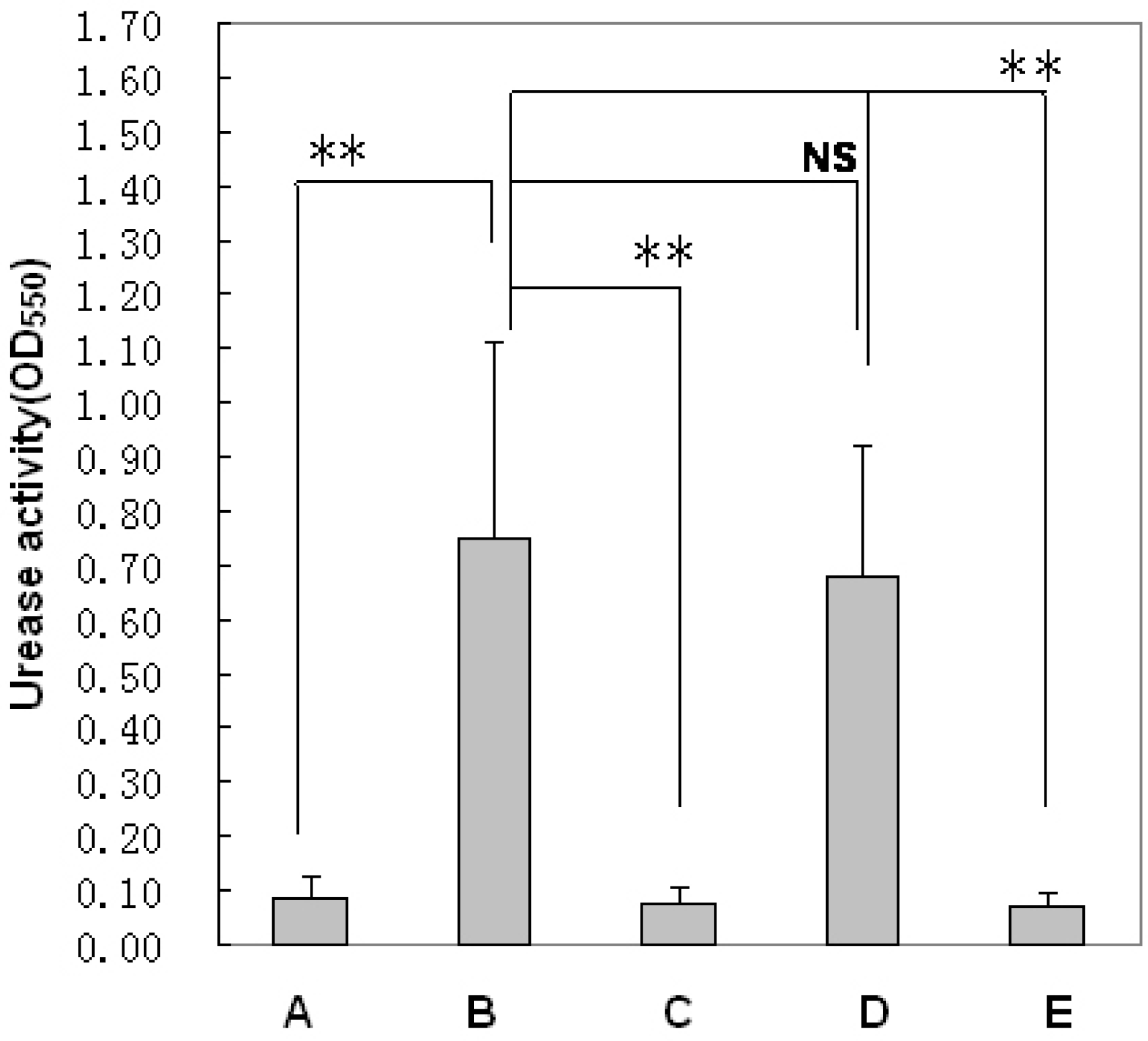The Synthetic Antimicrobial Peptide Pexiganan and Its Nanoparticles (PNPs) Exhibit the Anti-Helicobacter pylori Activity in Vitro and in Vivo
Abstract
:1. Introduction
2. Results and Discussion
2.1. MICs
| Clinic Strains | MIC (µg/mL) | ||
|---|---|---|---|
| Pexiganan | PNPs | Placebo Nanoparticles | |
| Gastric ulcer strain | 4 | 4 | ND |
| Gastric cancer strain | 4 | 4 | ND |
| ATCC 43504 | 4 | 4 | ND |
2.2. In Vitro Antibacterial Activity

2.3. In Vitro Resistance Studies

2.4. In Vivo Bioadhesivity

2.5. In Vivo H. pylori Clearance Efficiency

| Formulations | Dose (mg/kg) | Clearance Rate (No of Mice Cleared Infection/Total No) (%) | Bacterial Recovery (Log CFU/Stomach) |
|---|---|---|---|
| Vehicle control Pexiganan (peptide) | 0 | 0/6(0) | 7.87 ± 0.83 |
| 1 | 0/6(0) | 7.62 ± 0.61 | |
| 3 | 0/6(0) | 5.87 ± 0.52 | |
| 10 | 0/6(17) | 3.29 ± 0.37 | |
| 30 | 3/6(50) | 1.86 ± 0.28 | |
| Placebo nanoparticles (control) PNPs | 0 | 0/6(0) | 6.73 ± 0.54 |
| 1 | 1/6(17) | 4.18 ± 0.93 | |
| 3 | 4/6(67) | 1.57 ± 0.78 | |
| 10 | 6/6(100) | ND | |
| 30 | 6/6(100) | ND |
3. Experimental Section
3.1. Agents
3.2. Animals
3.3. In Vitro Growth Inhibition Studies of pexiganan and PNPs
3.4. In Vitro Kinetics Studies of Pexiganan and PNPs
3.5. In Vitro Resistance Assays of pexiganan and PNPs
3.6. Evaluation Gastric Mucoadhesion of pexiganan and PNPs
3.7. In Vivo H. Pylori Clearance Study of pexiganan and PNPs
3.8. Statistics
4. Conclusions
Acknowledgments
Author Contributions
Conflicts of Interest
References
- Fennerty, M.B.; Lieberman, D.A.; Vakil, N.; Magaret, N.; Faigel, D.O.; Helfand, M. Effectiveness of Helicobacter pylori therapies in a clinical practice setting. Arch. Intern. Med. 1999, 159, 1562–1566. [Google Scholar] [CrossRef] [PubMed]
- Osborn, J.F.; Cattaruzza, M.S.; Ferri, A.M.; de Angelis, F.; Renzi, D.; Marani, A.; Vaira, D. How long will it take to reduce gastric cancer incidence by eradicating Helicobacter pylori infection? Cancer Prev. Res (Phila) 2013, 6, 695–700. [Google Scholar] [CrossRef]
- Shah, S.; Qaqish, R.; Patel, V.; Amiji, M. Evaluation of the factors influencing stomach-specific delivery of antibacterial agents for Helicobacter pylori infection. J. Pharm. Pharmacol. 1999, 51, 667–672. [Google Scholar] [CrossRef] [PubMed]
- </i>Lin, C.K.; Hsu, P.I.; Lai, K.H.; Lo, G.H.; Tseng, H.H.; Lo, C.C.; Peng, N.J.; Chen, H.C.; Jou, H.S.; Huang, W.K.; et al. One-week quadruple therapy is an effective salvage regimen for Helicobacter pylori infection in patients after failure of standard triple therapy. J. Clin. Gastroenterol. 2002, 34, 547–551. [Google Scholar] [CrossRef] [PubMed]
- Liou, J.M.; Chen, C.C.; Chen, M.J.; Chen, C.C.; Chang, C.Y.; Fang, Y.J.; Lee, J.Y.; Hsu, S.J.; Luo, J.C.; Chang, W.H.; et al. Taiwan Helicobacter Consortium. Sequential versus triple therapy for the first-line treatment of Helicobacter pylori: A multicenter, open-label, randomized trial. Lancet 2013, 381, 205–213. [Google Scholar] [CrossRef] [PubMed]
- Stenstroem, B.; Mendis, A.; Marshall, B. Helicobacter pylori: The latest in diagnosis and treatment. Aust. Fam. Phys. 2008, 37, 608–612. [Google Scholar]
- Harris, M.; Mora-Montes, H.M.; Gow, N.A.; Coote, P.J. Loss of mannosyl-phosphate from Candida albicans cell wall proteins results in enhanced resistance to the inhibitory effect of a cationic antimicrobial peptide via reduced peptide binding to the cell surface. Microbiology 2009, 155, 1058–1070. [Google Scholar] [CrossRef] [PubMed]
- Bradshaw, J. Cationic antimicrobial peptides: Issues for potential clinical use. Bio Drugs 2003, 17, 233–240. [Google Scholar]
- Peschel, A.; Sahl, H.G. The co-evolution of host cationic antimicrobial peptides and microbial resistance. Nat. Rev. Microbiol. 2006, 4, 529–536. [Google Scholar] [CrossRef] [PubMed]
- Peters, B.M.; Shirtliff, M.E.; Jabra-Rizk, M.A. Antimicrobial peptides: Primeval molecules or future drugs? PLoS Pathog. 2010, 6, e1001067. [Google Scholar] [CrossRef] [PubMed]
- Brown, K.L.; Hancock, R.E. Cationic host defense (antimicrobial) peptides. Curr. Opin. Immunol. 2006, 18, 24–30. [Google Scholar] [CrossRef] [PubMed]
- Diamond, G.; Beckloff, N.; Weinberg, A.; Kisich, K.O. The roles of antimicrobial peptides in innate host defense. Curr. Pharm. Des 2009, 15, 2377–2392. [Google Scholar] [CrossRef] [PubMed]
- Mader, J.S.; Hoskin, D.W. Cationic antimicrobial peptides as novel cytotoxic agents for cancer treatment. Expert. Opin. Investig. Drugs 2006, 15, 933–946. [Google Scholar] [CrossRef] [PubMed]
- Mookherjee, N.; Hancock, R.E. Cationic host defence peptides: Innate immune regulatory peptides as a novel approach for treating infections. Cell. Mol. Life Sci. 2007, 64, 922–933. [Google Scholar] [CrossRef] [PubMed]
- Steinstraesser, L.; Koehler, T.; Jacobsen, F.; Daigeler, A.; Goertz, O.; Langer, S.; Kesting, M.; Steinau, H.; Eriksson, E.; Hirsch, T. Host defense peptides in wound healing. Mol. Med. 2008, 14, 528–537. [Google Scholar] [CrossRef] [PubMed]
- Ge, Y.; MacDonald, D.L.; Holroyd, K.H.; Thornsberry, C.; Wexler, H.; Zasloff, M. In vitro antibacterial properties of pexiganan, an analog of magainin. Antimicrob. Agents Chemother. 1999, 43, 782–788. [Google Scholar] [PubMed]
- Nagahara, N.; Akiyama, Y.; Tada, M.; Nakao, M.; Kitano, M.; Ogawa, Y. Mucoadhesive microspheres containing amoxycillin for clearance of Helicobacter pylori. Antimicrob. Agents. Chemother. 1998, 42, 2492–2494. [Google Scholar] [PubMed]
- Lin, Y.H.; Chang, C.H.; Wu, Y.S.; Hsu, Y.M.; Chiou, S.F.; Chen, Y.J. Development of pH-responsive chitosan/heparin nanoparticles for stomach-specific anti-Helicobacter pylori therapy. Biomaterials 2009, 30, 3332–3342. [Google Scholar] [CrossRef] [PubMed]
- Patel, J.K.; Patel, M.M. Stomach specific anti-Helicobacter pylori therapy: Preparation and evaluation of amoxicillin loaded chitosan mucoadhesive microspheres. Curr. Drug. Deliv. 2007, 4, 41–50. [Google Scholar] [CrossRef] [PubMed]
- Ishak, R.A.H.; Awad, G.A.S.; Mortada, N.D.; Nour, S.A.K. Preparation, in vitro and in vivo evaluation of stomach specific metronidazole loaded alginate beads as local anti-Helicobacter pylori therapy. J. Control. Release 2007, 119, 207–214. [Google Scholar] [CrossRef] [PubMed]
- Lehr, C.M.; Bodde, H.E.; Bouwstra, J.A.; Junginger, H.E. A surface energy analysis of mucoadhesion. II. Prediction of mucoadhesive performance by spreading coefficients. Eur. J. Pharm. Sci 1993, 1, 19–30. [Google Scholar] [CrossRef]
- Deacon, M.P.; McGurk, S.; Roberts, C.J.; Williams, P.M.; Tendler, S.J.; Davies, M.C.; Davis, S.S.; Harding, S.E. Atomic force microscopy of gastric mucin and chitosan mucoadhesive systems. Biochem. J. 2000, 348, 557–563. [Google Scholar] [CrossRef] [PubMed]
- Peretz, A.; Paritsky, M.; Nasser, O.; Brodsky, D.; Glyatman, T.; Segal, S.; On, A. Resistance of Helicobacter pylori to tetracycline, amoxicillin, clarithromycin and metronidazole in Israeli children and adults. J. Antibiot. (Tokyo) 2014, 67, 555–557. [Google Scholar] [CrossRef]
- Navon-Venezia, S.; Feder, R.; Gaidukov, L.; Carmeli, Y.; Mor, A. Antibacterial properties of dermaseptin S4 derivatives with in vivo activity. Antimicrob. Agents Chemother. 2002, 46, 689–694. [Google Scholar] [CrossRef] [PubMed]
- Radzishevsky, I.S.; Rotem, S.; Bourdetsky, D.; Navon-Venezia, S.; Carmeli, Y.; Mor, A. Improved antimicrobial peptides based on acyl-lysine oligomers. Nat. Biotechnol. 2007, 25, 657–659. [Google Scholar] [CrossRef] [PubMed]
- Eren, T.; Som, A.; Rennie, J.R.; Nelson, C.F.; Urgina, Y.; Nüsslein, K.; Coughlin, E.B.; Tew, G.N. Antibacterial and hemolytic activities of quaternary pyridinium functionalized polynorbornenes. Macromol. Chem. Phys. 2008, 209, 516–524. [Google Scholar] [CrossRef]
- Lamb, H.M.; Wiseman, L.R. Pexiganan Acetate. Drugs 1998, 56, 1047–1052. [Google Scholar] [CrossRef] [PubMed]
- Gottler, L.M.; Ramamoorthy, A. Structure, membrane orientation, mechanism, and function of pexiganan-a highly potent antimicrobial peptide designed from magainin. Biochim. Biophys. Acta 2009, 88, 1680–1686. [Google Scholar] [CrossRef]
- Hallock, K.J.; Lee, D.K.; Ramamoorthy, A. MSI-78, an analogue of the magainin antimicrobial peptides, disrupts lipid bilayer structure via positive curvature strain. Biophys. J. 2003, 84, 3052–3060. [Google Scholar] [CrossRef] [PubMed]
- Dvinskikh, S.V.; Dürr, U.H.N.; Yamamoto, K.; Ramamoorthy, A. A high-resolution solid-state NMR approach for the structural studies of bicelles. J. Am. Chem. Soc. 2006, 128, 6326–6327. [Google Scholar] [CrossRef] [PubMed]
- Algood, H.M.S.; Cover, T.L. Helicobacter pylori persistence: An overview of interactions between H. pylori and host immune defenses. Clin. Microbiol. Rev. 2006, 19, 597–613. [Google Scholar] [CrossRef] [PubMed]
- Cuña, M.; Alonso, M.J.; Torres, D. Preparation and in vivo evaluation of mucoadhesive microparticles containing amoxicillin-resin complexes for drug delivery to the gastric mucosa. Eur. J. Pharm. Biopharm. 2001, 51, 199–205. [Google Scholar] [CrossRef] [PubMed]
- Cooreman, M.P.; Krausgrill, P.; Hengels, K.J. Local gastric and serum amoxicillin concentrations after different oral application forms. Antimicrob. Agents Chemother. 1993, 37, 1506–1509. [Google Scholar] [CrossRef] [PubMed]
- Rajinikanth, P.S.; Balasubramaniam, J.; Mishra, B. Development and evaluation of a novel floating in situ gelling system of amoxicillin for eradication of Helicobacter pylori. Int. J. Pharm. 2007, 335, 114–122. [Google Scholar] [CrossRef] [PubMed]
- Calvo, P.; Lopez, C.R.; Jato, J.L.C.; Alonso, M.J. Novel hydrophilic chitosan-polyethylene oxide nanoparticles as protein carriers. J. Appl. Poly. Sci. 1997, 63, 125–132. [Google Scholar] [CrossRef]
- Arora, S.; Gupta, S.; Narang, R.K.; Budhiraja, R.D. Amoxicillin loaded chitosan–alginate polyelectrolyte complex nanoparticles as mucopenetrating delivery system for H. pylori. Sci. Pharm. 2011, 79, 673–694. [Google Scholar] [CrossRef] [PubMed]
- Akiyama, Y.; Nagahara, N.; Tashihara, T.; Morimoto, K.; Tabata, Y.; Ikada, Y. In vitro and in vivo evaluation of mucoadhesive microspheres prepared for the gastrointestinal tract using polyglycerol esters of fatty acids and a poly(acrylic acid) derivative. Pharm. Res. 1995, 12, 397–405. [Google Scholar] [CrossRef] [PubMed]
- Kleanthous, H.; Myers, G.A.; Georgakopoulos, K.M.; Tibbitts, T.J.; Ingrassia, J.W.; Gray, H.L.; Ding, R.; Zhang, Z.Z.; Lei, W.; Nichols, R.; et al. Rectal and intranasal immunizations with recombinant urease induce distinct local and serum immune responses in mice and protect against Helicobacter pylori infection. Infect. Immun. 1998, 66, 2879–2886. [Google Scholar] [PubMed]
- Ferrero, R.L.; Thiberge, J.M.; Huerre, M.; Labigne, A. Immune responses of specific- pathogen-free mice to chronic Helicobacter pylori (strain SS1) infection. Infect. Immun. 1998, 66, 1349–1355. [Google Scholar] [PubMed]
- Sample Availability: Samples of the compounds are available from the authors.
© 2015 by the authors. Licensee MDPI, Basel, Switzerland. This article is an open access article distributed under the terms and conditions of the Creative Commons Attribution license ( http://creativecommons.org/licenses/by/4.0/).
Share and Cite
Zhang, X.-L.; Jiang, A.-M.; Ma, Z.-Y.; Li, X.-B.; Xiong, Y.-Y.; Dou, J.-F.; Wang, J.-F. The Synthetic Antimicrobial Peptide Pexiganan and Its Nanoparticles (PNPs) Exhibit the Anti-Helicobacter pylori Activity in Vitro and in Vivo. Molecules 2015, 20, 3972-3985. https://doi.org/10.3390/molecules20033972
Zhang X-L, Jiang A-M, Ma Z-Y, Li X-B, Xiong Y-Y, Dou J-F, Wang J-F. The Synthetic Antimicrobial Peptide Pexiganan and Its Nanoparticles (PNPs) Exhibit the Anti-Helicobacter pylori Activity in Vitro and in Vivo. Molecules. 2015; 20(3):3972-3985. https://doi.org/10.3390/molecules20033972
Chicago/Turabian StyleZhang, Xiao-Lin, An-Min Jiang, Zhong-You Ma, Xian-Bao Li, You-Yi Xiong, Jin-Feng Dou, and Jian-Fei Wang. 2015. "The Synthetic Antimicrobial Peptide Pexiganan and Its Nanoparticles (PNPs) Exhibit the Anti-Helicobacter pylori Activity in Vitro and in Vivo" Molecules 20, no. 3: 3972-3985. https://doi.org/10.3390/molecules20033972
APA StyleZhang, X.-L., Jiang, A.-M., Ma, Z.-Y., Li, X.-B., Xiong, Y.-Y., Dou, J.-F., & Wang, J.-F. (2015). The Synthetic Antimicrobial Peptide Pexiganan and Its Nanoparticles (PNPs) Exhibit the Anti-Helicobacter pylori Activity in Vitro and in Vivo. Molecules, 20(3), 3972-3985. https://doi.org/10.3390/molecules20033972





